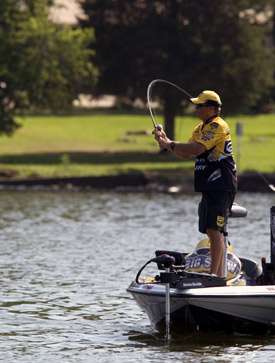
While most early fall advice focuses on shallow cranking, a few pros have kept these lesser-known tactics to themselves for success in the transition between seasons.
Ditch the lip
While most anglers are tossing square-billed crankbaits, Kelly Jordon goes against the grain when he pulls out his Lucky Craft LV-500 lipless crankbait.
"This time of year, you need to find the baitfish fast, and when you can't see them, lipless crankbaits are one of the best ways to do it," he says. "You can cast these things a mile, and fish them at any depth."
Jordon prefers a 1/2-ounce LV-500 in chrome and blue and will use 30-pound-test Spiderwire Ultra Cast if he's fishing around shoreline grass, and 12- to 20-pound-test Trilene 100% Fluorocarbon when in open water. He will use heavier fluorocarbon if he wants a faster fall rate, and lighter for a slower fall.
Jordon will employ one of several retrieves, depending on where he's fishing and what the fish want.
"I'll typically stick to shallow flats either in the main lake or in creek channels, wherever there is activity," he says. "The beauty of these baits is that they're incredibly versatile.
"I'll burn it over the tops of grass and across shallow flats, or if they're deeper I'll let it sink and hop it off the bottom in a yo-yoing action. This comes in handy when a cold front comes through that may have killed some shad off and the bass are looking to pick up an easy meal on the bottom."
Don't hang up the summer patterns
As a Florida native, Terry Scroggins knows that the Sunshine State has its peculiarities when it comes to fall fishing. He uses patterns that are more commonly seen in other parts of the country.
"Florida is a little different than the rest of the country, so you need different approaches," he says. "Don't count out deep presentations like deep cranking and Carolina rigs."
Scroggins says the most important thing to remember in early fall is to look for bait, either with your eyes or your graph.
"The fish are gorging on shad now to prepare for the winter and eventually spawn, so they go wherever there's food, which includes deep water."
If there's no visible surface activity, Scroggins will turn to his graph and find offshore structure, notably ledges and shell beds. He prefers Bomber's Fat Free Shad in vibrant colors for dark water and natural greens and browns for clear water. He cranks with a 7-foot medium action rod paired with a 6.3:1 gear ratio reel spooled with 10-pound-test fluorocarbon for extra long casts.
Scroggins will cast beyond his underwater target so his Fat Free Shad will be at its deepest when it crosses the structure. He makes sure to have the bait dig around in the bed or on the ledge then starts a stop-and-go retrieve after it bottoms out.
"The stop-and-go keeps the bait in the strike zone longer and gives it a more erratic action," he says. "Cranking will usually get you bigger fish, but if that doesn't work I'll slow down and go to a Carolina rig to try and get them fired up."
If he knows the area he's fishing holds fish, he says there's no reason to move. Simply give them something different to look at.
Scroggins positions his boat for Carolina riggings the same way he does for cranking — far away — then makes long casts with the Carolina rig. He uses a 1-ounce sinker with a three- to four-foot leader, using the latter if there is a strong current. Straight shank hooks dug into 5-inch Yum Houdini worms see most of his Carolina rig work. He uses green pumpkin or watermelon in clear water and a Florida favorite, junebug, in stained water.
"After you cast past your target, bring it in slowly 'til you feel the cover you're after. Once you feel the roughness of the shell bed, let it soak," he says. "You're in the strike zone."
Scroggins admits that these may not be popular options on a lot of waters outside of Florida, but also believes that they are just as effective if you can find the bait or good offshore structure since some fish may not be actively chasing bait yet.
Don't be afraid to cross seasonal pattern boundaries if your Bagley Balsa B isn't panning out. The fish may not have caught up yet, or you may be too far ahead.
Originally published September 2008




